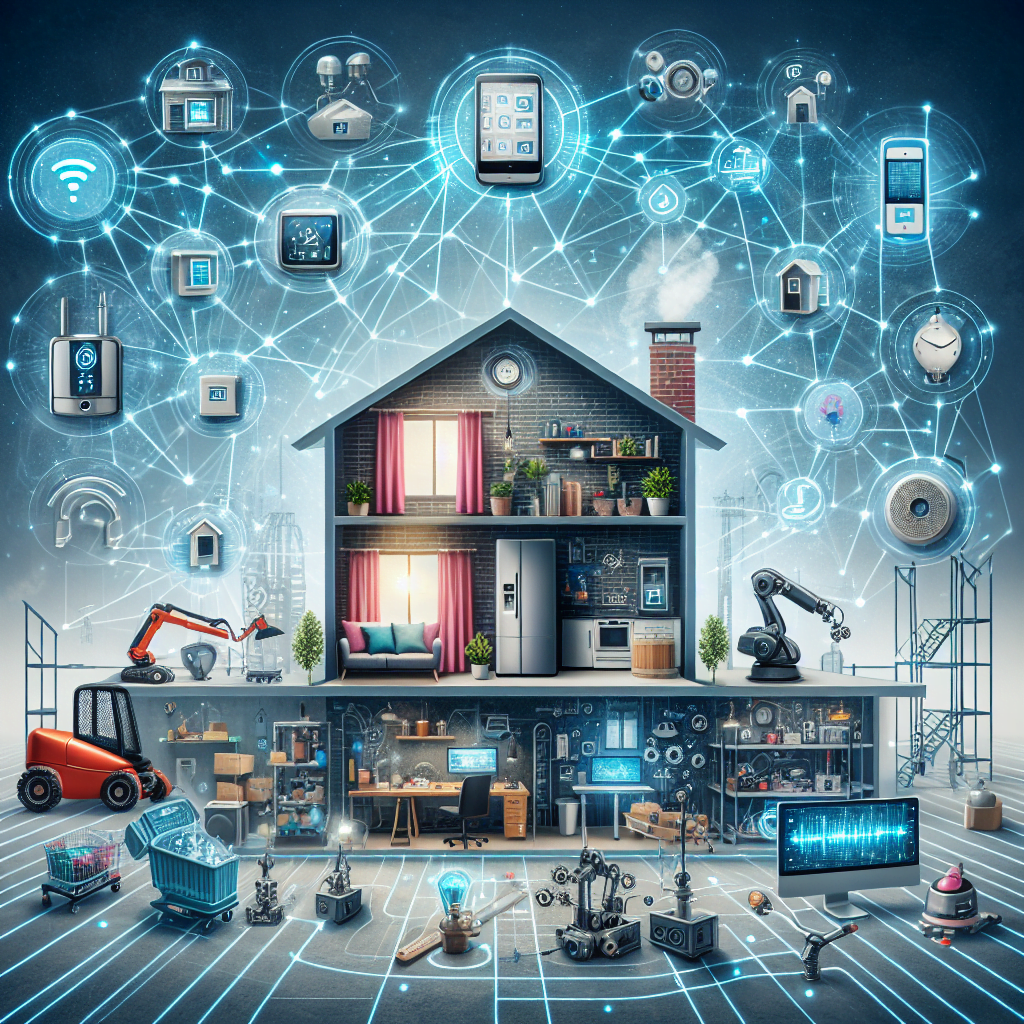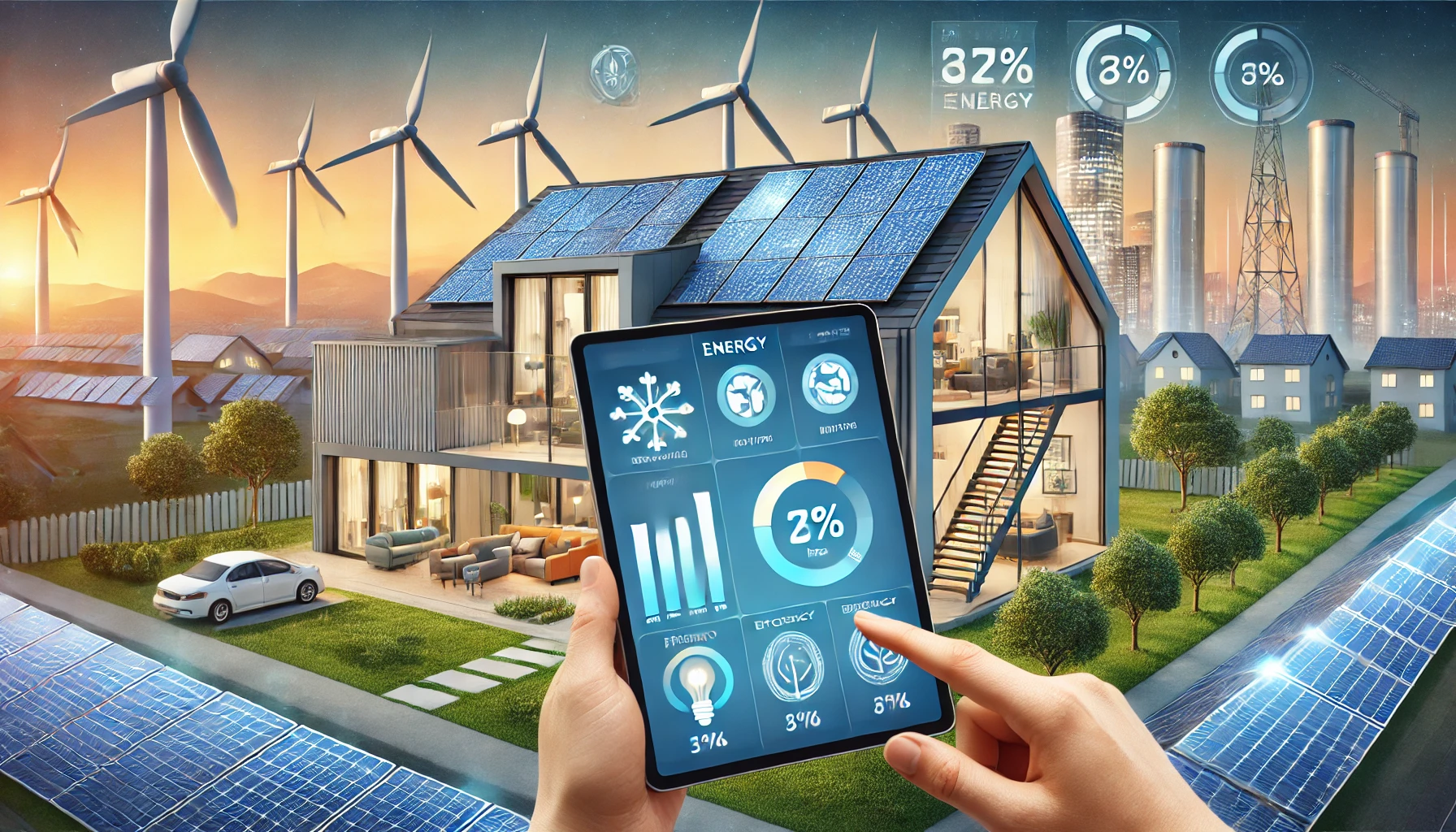IoT, or the Internet of Things, is revolutionizing the way we live and work. With the ability to connect everyday objects to the internet and make them “smart,” the possibilities for efficiency, convenience, and innovation are endless. From smart homes that can automate tasks and enhance security, to wearable devices that track our health and fitness goals, IoT is reshaping our daily lives. In the workplace, IoT is streamlining processes, improving productivity, and creating new business opportunities. As more devices and sensors become interconnected, the potential impact of IoT on our lives and work is only just beginning to be realized.

Advantages of IoT in Daily Life
Smart Homes
IoT technology has transformed the way we live in our homes, making them smarter and more efficient than ever before. With the integration of IoT devices, you can control various aspects of your home, such as lighting, temperature, and security, with just a few taps on your smartphone. Imagine being able to adjust the brightness of your lights or turn on your air conditioning before you even step foot inside your house. IoT-enabled smart homes offer convenience, comfort, and energy efficiency, providing you with a seamless and enjoyable living experience.
Healthcare
The application of IoT in healthcare is revolutionizing the industry and transforming the way we receive medical care. IoT devices have enabled remote patient monitoring, allowing doctors to keep track of their patients’ health in real-time. This technology is particularly beneficial for patients with chronic illnesses or those who require constant monitoring. Furthermore, IoT devices can assist in improving patient safety within hospitals by monitoring medication dispensing and reducing the risk of errors. Overall, IoT has the potential to enhance healthcare outcomes, provide personalized care, and increase patient convenience.
Transportation
The integration of IoT technology in transportation systems has created a more streamlined and efficient way of commuting. Smart vehicles equipped with IoT devices can communicate with each other, traffic lights, and road infrastructure, allowing for better traffic management and reducing congestion. Additionally, IoT technology has improved vehicle safety by providing real-time data on potential hazards, enabling drivers to make informed decisions and avoid accidents. Furthermore, infotainment systems in automobiles provide passengers with a range of entertainment options, making their travel experience more enjoyable and convenient.
IoT’s Impact on the Workplace
Improving Efficiency and Productivity
IoT technology has a significant impact on workplace efficiency and productivity. By connecting various devices and systems in an office environment, businesses can automate routine tasks, eliminating the need for manual intervention and freeing up employees’ time. For example, IoT-enabled smart office systems can automatically adjust lighting and temperature settings based on occupancy, reducing energy waste and employee discomfort. Moreover, IoT devices can collect and analyze data to identify bottlenecks in processes, allowing businesses to optimize workflows and enhance productivity.
Enhancing Communication and Collaboration
With IoT technology, communication and collaboration in the workplace have been elevated to a new level. IoT devices such as smart sensors, connected whiteboards, and video conferencing systems enable seamless communication between employees, regardless of their physical location. These devices facilitate real-time collaboration, allowing teams to work together on projects, share ideas, and make decisions more efficiently. The increased connectivity and communication offered by IoT devices have led to improved teamwork, faster decision-making, and ultimately, increased productivity.
Creating Smart Offices
The concept of a smart office has become a reality with the advent of IoT technology. Smart office systems integrate various devices and technologies to create an intelligent and connected workplace. For instance, IoT-enabled smart lighting systems can adjust lighting levels based on natural light, occupancy, or employee preferences, promoting energy efficiency and employee well-being. Smart office systems can also monitor and optimize energy consumption, automatically adjust room temperatures, and manage security and access control. These features not only create a more comfortable and productive work environment but also contribute to cost savings and sustainability.
IoT in Agriculture and Farming
Precision Farming
IoT has revolutionized agriculture by enabling precision farming techniques. Through the use of IoT sensors, farmers can monitor and collect data on various environmental factors such as soil moisture, temperature, and nutrient levels. This data is then analyzed by IoT platforms, which provide valuable insights and recommendations to optimize farming operations. Precision farming techniques allow farmers to make informed decisions regarding irrigation, fertilization, and pest control, resulting in increased crop yields, reduced resource consumption, and improved sustainability.
Livestock Monitoring
IoT devices have also been instrumental in livestock monitoring, ensuring the well-being and productivity of animals. Through the use of sensors and wearable devices, farmers can monitor the health, activity levels, and location of their livestock. This real-time data allows farmers to detect any potential health issues early on, provide timely interventions, and optimize feeding and breeding practices. Livestock monitoring systems enhance animal welfare, minimize losses, and improve overall farm management.
Irrigation Management
Effective irrigation management is crucial for agricultural productivity, water conservation, and environmental sustainability. IoT technology enables farmers to monitor soil moisture levels, weather conditions, and crop water requirements in real-time. By collecting and analyzing this data, farmers can optimize irrigation schedules, reduce water waste, and ensure that crops receive the necessary amount of water for healthy growth. IoT-based irrigation management systems enable efficient water usage, reduce costs, and contribute to sustainable farming practices.
Revolutionizing Healthcare with IoT
Remote Patient Monitoring
Remote patient monitoring is a game-changer in healthcare, made possible by IoT technology. With IoT-enabled devices such as wearable sensors and mobile apps, healthcare providers can track patients’ vital signs, medication adherence, and overall health remotely. This allows for early detection of potential health issues, timely interventions, and reduced hospital visits. Remote patient monitoring improves patient outcomes, enables personalized care, and facilitates continuous monitoring of chronic conditions.
Smart Hospitals
IoT technology is transforming traditional hospitals into smart hospitals, improving operational efficiency and patient care. IoT devices, such as connected medical equipment and smart beds, can transmit real-time data to centralized platforms, enabling healthcare professionals to monitor patient status and make informed decisions. Moreover, IoT-enabled asset tracking and inventory management systems ensure that medical supplies and equipment are readily available when needed, preventing delays in patient care. Smart hospitals streamline workflows, reduce errors, and enhance overall patient satisfaction.
Improved Patient Safety
IoT technology plays a crucial role in ensuring patient safety within healthcare facilities. For instance, IoT devices can monitor and control the temperature and humidity of sensitive medication storage areas, ensuring optimal conditions for drug efficacy. IoT systems can also monitor hand hygiene compliance, automatically reminding healthcare workers to sanitize their hands before patient interactions. Additionally, smart wearable devices can alert healthcare providers in real-time in the event of patient falls or emergencies, enabling immediate response and minimizing risks. IoT enhances patient safety, reduces medical errors, and improves overall healthcare quality.
Transportation and Mobility
Smart Vehicles
IoT has ushered in the era of smart vehicles, transforming the way we commute and travel. Connected cars equipped with IoT devices can communicate with other vehicles, traffic infrastructure, and navigation systems, ensuring a safer and more efficient transportation experience. IoT technology enables features such as real-time traffic updates, predictive maintenance, and emergency assistance, enhancing driver convenience and safety. Moreover, smart vehicles can analyze driving patterns and provide feedback on fuel efficiency, promoting eco-friendly driving practices and reducing carbon emissions.
Smart Traffic Management
IoT technology is instrumental in managing traffic congestion and improving transportation efficiency. Connected traffic management systems utilize real-time data from IoT sensors and smart devices to monitor traffic flow, detect bottlenecks, and optimize signal timings. Through intelligent traffic management, cities can reduce congestion, shorten travel times, and improve road safety. Furthermore, IoT technology enables the implementation of dynamic routing systems, guiding drivers through less congested routes and further reducing traffic-related frustrations.
Infotainment in Automobiles
IoT has also revolutionized in-car entertainment and connectivity. Infotainment systems in automobiles can seamlessly integrate with smartphones, allowing drivers to access navigation, music, and voice commands hands-free. Moreover, these systems can connect with streaming platforms and provide real-time information on news, sports, and weather updates. The integration of IoT technology in infotainment systems enhances the driving experience, keeps passengers entertained, and ensures connectivity on the go.
IoT in Energy Management
Smart Grids
The implementation of IoT in energy management has led to the development of smart grids, providing a more efficient and reliable energy distribution system. Smart grids utilize IoT sensors and devices to collect data on energy consumption, power quality, and demand patterns. This data enables utilities to analyze and optimize energy generation and distribution, reducing wastage and minimizing downtime. Smart grids also empower consumers by providing real-time energy usage information, allowing them to make informed decisions on energy conservation and cost savings.
Energy Usage Optimization
IoT technology enables energy usage optimization in various sectors, from residential buildings to industrial facilities. Smart meters equipped with IoT devices can monitor the energy consumption of individual appliances and provide real-time data on usage and costs. This information allows consumers to identify energy-intensive devices, detect abnormalities, and adjust their habits for more efficient energy usage. IoT-based energy management systems also enable demand-response programs, where electricity consumption can be adjusted during peak demand periods to optimize grid stability and reduce costs.
Renewable Energy Integration
The integration of renewable energy sources, such as solar and wind power, into the grid is made more efficient through IoT technology. IoT devices can monitor renewable energy generation, weather conditions, and load demand in real-time, optimizing the utilization and storage of renewable energy. This ensures a more stable and reliable energy supply, reducing reliance on fossil fuels and promoting sustainability. IoT-enabled renewable energy integration facilitates a smooth transition towards a greener and more environmentally friendly energy system.
Enhancing Manufacturing Processes with IoT
Industrial Automation
IoT technology has revolutionized manufacturing processes through the implementation of industrial automation. Connected machines equipped with IoT devices can communicate with each other and with central control systems, enabling efficient production and reducing human intervention. IoT-based industrial automation improves operational efficiency, reduces downtime, and enhances product quality. Moreover, IoT-enabled predictive maintenance systems can detect potential machine failures in advance, reducing maintenance costs and preventing unexpected breakdowns.
Predictive Maintenance
IoT technology enables predictive maintenance, ensuring optimal performance and reliability of industrial equipment. Sensors and IoT devices can collect real-time data on machine performance, analyze it using AI algorithms, and predict potential failures or maintenance needs. This proactive approach to maintenance allows businesses to schedule repairs and replacements during planned downtime, minimizing production losses and optimizing resource allocation. Predictive maintenance systems based on IoT technology improve equipment lifespan, reduce maintenance costs, and enhance overall operational efficiency.
Supply Chain Management
IoT plays a pivotal role in optimizing supply chain management processes. IoT-enabled devices, such as RFID tags and sensors, enable real-time tracking and monitoring of goods throughout the supply chain. This provides businesses with accurate visibility into inventory levels, location, and condition, allowing for more efficient inventory management and logistics planning. IoT technology also facilitates automated data collection, reducing manual errors and improving data accuracy. By streamlining supply chain processes, businesses can enhance order fulfillment, reduce costs, and deliver products more quickly and accurately.
Smart Cities and Urban Development
Smart Infrastructure
IoT technology is transforming cities into smart cities by enabling the development of intelligent infrastructure. Smart sensors and devices are integrated into urban infrastructure systems such as transportation, energy, and waste management. These sensors collect real-time data on various parameters, enabling smart decision-making and optimization of city services. For example, smart traffic lights can adjust signal timings based on traffic patterns, optimizing traffic flow and reducing congestion. Smart infrastructure systems improve the quality of life for residents, enhance environmental sustainability, and contribute to efficient resource utilization.
Waste Management
Efficient waste management is crucial for maintaining the cleanliness and sustainability of cities. IoT technology enables smart waste management systems that optimize waste collection, disposal, and recycling processes. Connected waste bins equipped with IoT devices can monitor their fill levels, allowing waste management authorities to schedule collection routes based on actual need, minimizing unnecessary pickups, and reducing costs. Furthermore, IoT-based sensors can monitor air quality and environmental conditions related to waste management activities, ensuring compliance with regulations and promoting a healthier urban environment.
Public Safety and Security
IoT technology enhances public safety and security in smart cities through various applications. Connected surveillance cameras equipped with advanced analytics can detect and respond to suspicious activities, enabling faster response times and crime prevention. IoT-enabled emergency response systems can automatically detect and report incidents, such as fires or accidents, to the relevant authorities, triggering timely interventions. Furthermore, IoT devices can monitor public infrastructure, such as bridges and buildings, for potential structural abnormalities, ensuring safety for residents and visitors. Smart cities leverage IoT technology to enhance public safety, reduce crime rates, and provide a secure urban environment.
IoT in Retail and Customer Service
Inventory Management
IoT technology has transformed inventory management in the retail sector, enabling businesses to track and manage inventory more efficiently. Connected RFID tags and sensors provide real-time data on inventory levels, location, and movement, automating inventory monitoring and reducing manual errors. This allows businesses to optimize inventory levels, minimize stockouts, and streamline supply chain operations. IoT-based inventory management systems enhance efficiency and accuracy, leading to improved customer satisfaction and increased profitability.
Enhanced Customer Experience
IoT technology enhances the retail customer experience by providing personalized and interactive interactions. With IoT-enabled devices such as smart fitting rooms, customers can try on clothes and receive recommendations based on their preferences and body measurements. Moreover, IoT-powered beacons can send personalized offers and promotions to customers’ smartphones based on their location within a store. These personalized experiences create a more engaging and enjoyable shopping journey, increasing customer satisfaction and loyalty.
Personalized Marketing
IoT technology enables personalized marketing strategies by collecting and analyzing data on customer behavior, preferences, and purchase history. By leveraging IoT devices such as smart sensors and beacons, businesses can deliver targeted advertisements and offers to customers at the right time and place. For example, a grocery store can send personalized recipes or product recommendations to customers’ smartphones based on their shopping history. Personalized marketing campaigns facilitated by IoT technology result in increased customer engagement, higher conversion rates, and improved marketing ROI.
Cybersecurity Challenges with IoT
Data Privacy and Protection
As IoT technology continues to proliferate, ensuring data privacy and protection becomes a significant challenge. IoT devices collect and transmit vast amounts of data, making them vulnerable to cyber threats and privacy breaches. Businesses and individuals must implement robust security measures to safeguard sensitive information and prevent unauthorized access. This includes encryption of data, secure authentication mechanisms, and regular software updates to address security vulnerabilities. Protecting data privacy and maintaining the confidentiality of IoT-generated data is essential for building trust and fostering the widespread adoption of IoT technology.
Network Vulnerabilities
The interconnected nature of IoT devices increases the risk of network vulnerabilities. Hackers can exploit weaknesses in IoT device security to gain unauthorized access to networks, causing potential disruptions or data breaches. To mitigate these risks, businesses and individuals must implement robust network security protocols, such as firewalls, intrusion detection systems, and network segmentation. Regular network monitoring and vulnerability assessments are essential for identifying and addressing potential weaknesses in IoT networks. By prioritizing network security, we can ensure the reliability and integrity of IoT systems.
IoT Device Security
The security of IoT devices themselves is a critical consideration in the IoT landscape. IoT devices often have limited computing power and memory, making them susceptible to security vulnerabilities. Manufacturers must prioritize implementing security mechanisms, such as secure boot processes, encryption, and regular firmware updates, to protect IoT devices from unauthorized access and tampering. Moreover, users must be vigilant in changing default passwords, updating device firmware, and adhering to security best practices. Secure IoT devices are crucial for maintaining data integrity, protecting user privacy, and ensuring the overall security of IoT ecosystems.
In conclusion, IoT technology has transformed various aspects of our lives, impacting daily routines, healthcare, transportation, energy management, manufacturing processes, urban development, retail, and cybersecurity. The advantages of IoT in daily life are evident, from the convenience and comfort provided by smart homes to the optimized workflows and enhanced productivity in smart offices. IoT has also revolutionized industries such as agriculture, healthcare, transportation, and energy management, enabling precision farming, improving patient care, optimizing transportation systems, and promoting sustainable energy practices. Moreover, IoT technology has facilitated the development of smart cities, enhancing infrastructure, waste management, public safety, and retail customer experiences. However, the widespread adoption of IoT technology also presents cybersecurity challenges, such as data privacy and protection, network vulnerabilities, and IoT device security. By addressing these challenges, we can fully harness the potential of IoT and continue to reap its benefits in our daily lives and workplaces.



